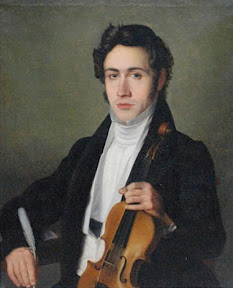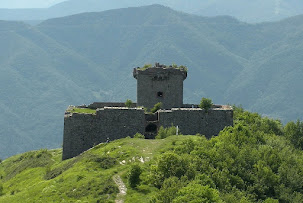Extraordinary talent aroused bizarre suspicions
 |
| Niccolò Paganini is widely regarded as one of history's greatest violinists |
Paganini’s ability was so far ahead of his contemporaries that to some observers it defied comprehension. He possessed unusually long fingers, a memory that enabled him to play entire pieces without the need for sheet music, and could play at up to 12 notes per second.
This, combined with his appearance - he was tall and thin, with hollow cheeks, pale skin and a fondness for dressing in black - and a habit of making wild, exaggerated movements as he played, gave rise to outlandish theories that he was possessed by the Devil, or even was the Devil himself.
He also pursued a somewhat dissolute lifestyle, drinking heavily, gambling and taking advantage of his fame to engage in numerous affairs.
The suspicion of demonic associations stayed with him all his life to the extent that after his death at the age of 58 it was four years before his body was laid to rest because the Catholic Church would not give him a Christian burial, their reticence not helped by his refusal to accept the last rites.
Only years later was it concluded that his long fingers were probably the result of a genetic disorder called Marfan syndrome, while the speed of his playing and jerky movements could have been symptoms of Ehlers-Danlos syndrome, another inherited condition, whose sufferers have increased flexibility but a lack of coordination.
 |
| Paganini has such an accurate memory that he could play without sheet music |
It was soon clear he was blessed with prodigious talent and was soon offered scholarships to study with local teachers in Genoa. His ability quickly outpaced what they could offer him, prompting his father to take him to Parma in search of more advanced tuition.
His progress was interrupted in 1796 when northern Italy was invaded by France and Paganini’s family left the city to move inland along the Polcevera river to Bolzaneto, where they owned another property. Paganini occupied himself by learning to play the guitar, again to an extraordinary standard, although it was an instrument he played largely for his own amusement and for close friends, rather than give public performances.
He embarked on his first solo violin tour at the age of 15, appearing at various places around Italy, but being away from home was not good for his mental health and it was thought that this pushed him towards drinking and gambling as an escape.
After he recovered, he was appointed first violin of the Republic of Lucca, at that time one of the most powerful city states in Italy, but in 1805 Lucca was annexed by Napoleonic France, and the region was ceded to Napoleon's sister, Elisa Baciocchi. Paganini stayed, becoming a violinist to the Baciocchi court. It was during this time that he composed perhaps his most famous work, his 24 Caprices for solo violin.
 |
| Paganini's violin Il Cannone Guarnerius |
It was not until after Pope Leo XII had conferred upon him the Order of the Golden Spur, the papal equivalent of a knighthood, in 1827, that his fame spread across Europe. The following year, he was invited to play in Vienna, followed by a prolonged tour that saw him perform in almost all the major cities of Germany, Poland and Bohemia. Later, he performed in Paris and London.
Still, his phenomenal ability attracted suspicion. In Vienna, an audience member claimed he had seen the Devil on stage with Paganini. A story circulated that the sound of a woman’s scream could be heard emanating from his violin while he played, the consequence, it was said, of his murdering a woman and making strings from her intestines, while imprisoning her soul within the body of the instrument.
Given such stories, it was hardly surprising that he made few friends. Two exceptions were Gioachino Rossini, the Italian composer he first met in Bologna in 1818 and for whom he once conducted an opera performance after the sudden death of the regular conductor, and Hector Berlioz, the French composer whom he compared with Beethoven and supported with large sums of money towards the end of his life.
Among his many romantic associations, the most enduring involved a singer from Como, Antonia Bianchi. After meeting in Milan in 1813 they gave concerts together throughout Italy. They had a son, Achille Ciro Alessandro, born in Palermo in 1825, but they were never married and split up in around 1828.
 |
| Paganini began learning the violin at the age of seven |
Touring soon became impossible and he returned to Genoa initially, giving lessons to a small number of pupils, including Camillo Sivori, who would go on to assume his mantle as Italy’s finest violinist.
Restless, he went back to Paris in 1836 and unwisely invested much money in a casino, which failed so badly he was forced to auction off many of his prized collection of violins and guitars, including several made by Antonio Stradavari in Cremona, in order to recoup his losses. He left Paris for Marseille in 1838 and from there went to Nice, which is where he died in 1840, apparently from internal bleeding as a result of cancer of the larynx. It was the Bishop of Nice who arranged for a local priest to visit him and perform the last rites, but Paganini refused to accept his life was nearing its end and dismissed the priest.
The local church refused to bury him on consecrated ground and his embalmed body remained in the house where he died for more than a year and in the Nice area for almost four years while his son, Achille, pleaded with the Catholic Church to allow his body to be moved back to Italy. Ultimately, Achille’s entreaties were answered by Pope Gregory XVI and Paganini’s body was finally laid to rest at La Villetta cemetery in Parma.
Travel tip:The Fratello Minore fortress above the
Polcevera valley outside Bolzaneto
Bolzaneto, where the Paganini family had a house while Niccolò was growing up, was once a hamlet located outside the city of Genoa in the Polcevera valley. Today it is a suburb of Genoa, surrounded by many small industries and business firms. On the mountains behind Bolzaneto, at the left side of Polcevera valley, are two fortresses, which are part of the external fortresses of Genoa: the Fort Diamante and a smaller fortress known as Fratello Minore. Close to the Bolzaneto exit of the A7 motorway that runs from Genoa to Milan is what used to be Bolzaneto’s castle, built in the early 14th century but subsequently destroyed in clashes between the Guelphs and Ghibbelines before being rebuilt and destroyed several times thereafter, finally as a grand residence at the beginning of the 20th century.
 |
| Paganini's tomb memorial at the La Villetta cemetery in Parma |
La Villetta, the monumental cemetery at Parma where Paganini’s body was finally buried and an elaborate memorial erected, takes its name after the farm that Duchess Marie Louise of Austria, the second wife of Napoleon, chose as the site for the city's burial ground during her rule of the city from 1816 to 1847. Designed by the engineer Giuseppe Cocconcelli in neoclassical style, it contains the tombs among others of the poet Angelo Mazza and the composer Ildebrando Pizzetti. Paganini’s tomb, housed under a domed portico supported by eight Doric columns, is on the left side of the entrance, opposite the main chapel dedicated to San Gregorio Magno.
Also on this day:
1952: The birth of Oscar-winning actor Roberto Benigni
1962: The death in a plane crash of industrialist Enrico Mattei
1967: The birth of mountaineer Simone Moro

No comments:
Post a Comment